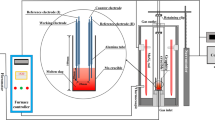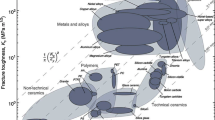Abstract
An inverse thermal analysis of Alloy 690 laser and hybrid laser–GMA welds is presented that uses numerical–analytical basis functions and boundary constraints based on measured solidification cross sections. In particular, the inverse analysis procedure uses three-dimensional constraint conditions such that two-dimensional projections of calculated solidification boundaries are constrained to map within experimentally measured solidification cross sections. Temperature histories calculated by this analysis are input data for computational procedures that predict solid-state phase transformations and mechanical response. These temperature histories can be used for inverse thermal analysis of welds corresponding to other welding processes whose process conditions are within similar regimes.


























Similar content being viewed by others
References
T. Allen, J. Busby, M. Meyer, and D. Petti, Materials Challenges for Nuclear Systems, Mater. Today, 2010, 13(12), p 14–23
J.J. Blecher, T.A. Palmer, and T. Debroy, Porosity in Thick Section Alloy 690 Welds—Experiments, Modeling, Mechanism, and Remedy, Weld. Res., 2016, 95, p 17–26
A. Tarantola, Inverse Problem Theory and Methods for Model Parameter Estimation, SIAM, Philadelphia, 2005
C.R. Vogel, Computational Methods for Inverse Problems, SIAM, Philadelphia, 2002
A.G. Ramm, Inverse Problems, Mathematical and Analytical Techniques with Applications to Engineering, Springer Science, New York, 2005
J.V. Beck, B. Blackwell, and C.R. St, Clair, Inverse Heat Conduction: IlI-Posed Problems, Wiley Interscience, New York, 1995
O.M. Alifanov, Inverse Heat Transfer Problems, Springer, New York, 1994
M.N. Ozisik and H.R.B. Orlande, Inverse Heat Transfer, Fundamentals and Applications, Taylor and Francis, New York, 2000
K. Kurpisz and A.J. Nowak, Inverse Thermal Problems, Computational Mechanics Publications, Boston, 1995
J.V. Beck, in Inverse Problems in Heat Transfer with Application to Solidification and Welding, ed. by V. M. Rappaz, M.R. Ozgu and K.W. Mahin. Modeling of Casting, Welding and Advanced Solidification Processes (The Minerals, Metals and Materials Society, Pittsburgh, 1991), p. 427–437.
J.V. Beck, in Inverse Problems in Heat Transfer, ed. by G.E. Tupholme, A.S. Wood. Mathematics of Heat Transfer (Clarendon Press, Wotton-under-Edge, 1998), p. 13–24.
A.N. Tikhonov, Inverse Problems in Heat Conduction, J. Eng. Phys., 1975, 29(1), p 816–820
O.M. Alifanov, Solution of an Inverse Problem of Heat-Conduction by Iterative Methods, J. Eng. Phys., 1974, 26(4), p 471–476
O.M. Alifanov and V.Y. Mikhailov, Solution of the Overdetermined Inverse Problem of Thermal Conductivity Involving Inaccurate Data, High Temp., 1985, 23(1), p 112–117
E.A. Artyukhin and A.V. Nenarokomov, Coefficient Inverse Heat Conduction Problem, J. Eng. Phys., 1988, 53, p 1085–1090
T.J. Martin and G.S. Dulikravich, Inverse Determination of Steady Convective Local Heat Transfer Coefficients, ASME J. Heat Transfer, 1998, 120, p 328–334
S.G. Lambrakos and S.G. Michopoulos, Algorithms for Inverse Analysis of Heat Deposition Processes. Mathematical Modelling of Weld Phenomena, Volume 8, 847, Published by Verlag der Technischen Universite Graz, Austria (2007).
S.G. Lambrakos and J.O. Milewski, Analysis of Welding and Heat Deposition Processes using an Inverse-Problem Approach, Mathematical Modelling of Weld Phenomena, 7, 1025, Publishied by Verlag der Technischen Universite Graz, Austria, 2005, p. 1025–1055.
S.G. Lambrakos, Inverse Thermal Analysis of 304L Stainless Steel Laser Welds, J. Mater. Eng. And Perform., 2013, 22(8), p 2141
S.G. Lambrakos, Inverse Thermal Analysis of Stainless Steel Deep-Penetration Welds Using Volumetric Constraints. J. Mater. Eng. Perform. 23(6), 2219–2232. doi:10.1007/s11665-014-1023-7.
S.G. Lambrakos, Inverse Thermal Analysis of Welds Using Multiple Constraints and Relaxed Parameter Optimization, J. Mater. Eng. Perform., 2015, 24(8), p 2925–2936
D. Rosenthal, The Theory of Moving Sources of Heat and its Application to Metal Treatments, Trans. ASME, 1946, 68, p 849–866
J. Goldak, A. Chakravarti, and M. Bibby, A New Finite Element Model for Welding Heat Source, Metall. Trans. B, 1984, 15, p 299–305
R.O. Myhr and O. Grong, Acta Metall. Mater. 38, 449–460 (1990).
O. Grong, Materials Modelling Series, Metallurgical Modelling of Welding, Vol Chapter 2, 2nd ed., H.K.D.H. Bhadeshia, Ed., The Institute of Materials, London, 1997, p 1–115
R.C. Reed and H.K.D.H. Bhadeshia, A Simple Model For Multipass Welds, Acta Metall. Mater., 1994, 42(11), p 3663–3678
V.A. Karkhin, P.N. Homich and V.G. Michailov, “Models for Volume Heat Sources and Functional-Analytic Technique for Calculating the Temperature Fields in Butt Welding, ‘Mathematical Modelling of Weld Phenomena,’ Volume 8, 847, Published by Verlag der Technischen Universite Graz, Austria (2007).
I.S. Leoveanu, G. Zgura and D. Birsan, “Modeling the Heat and Fluid Flow in the Welded Pool,” Bulletin of the Transsilvania University of Brasov, Vol. 3, pp. 363–368, ISSN 1223-9631 (2007).
I.S. Leoveanu and G. Zgura, in Modelling the Heat and Fluid Flow in the Welded Pool from High Power Arc Sources, ed. by C. Lee, J-B. Lee, D-H. Park, S-J. Na. Materials Science Forum, Vols. 580–582, pp. 443–446 (2008).
S.G. Lambrakos, Parametric Modeling of Welding Processes Using Numerical-Analytical Basis Functions and Equivalent Scource Distributions, J. Mater. Eng. Perform., 2016, 25(4), p 1360–1375
Acknowledgment
This work was supported by a Naval Research Laboratory (NRL) internal core program.
Author information
Authors and Affiliations
Corresponding author
Rights and permissions
About this article
Cite this article
Lambrakos, S.G. Inverse Thermal Analysis of Alloy 690 Laser and Hybrid Laser–GMA Welds Using Solidification-Boundary Constraints. J. of Materi Eng and Perform 26, 3877–3891 (2017). https://doi.org/10.1007/s11665-017-2838-9
Received:
Revised:
Published:
Issue Date:
DOI: https://doi.org/10.1007/s11665-017-2838-9




